Detailed Solution: IT Infrastructure Management Assignment Analysis
VerifiedAdded on 2020/03/01
|9
|2374
|53
Homework Assignment
AI Summary
This assignment solution covers key concepts in IT Infrastructure Management. It begins by defining important terminologies like Just-in-Time Delivery, E-Commerce, SaaS, Strategic Planning, Supply Chain systems, DSS, Cloud infrastructure, Web 2, Extranet, and Big data analysis. The solution then delves into the key elements of data mining, illustrating them with examples, and explains the significance of 'Reserve Stock Level' function within ERP systems. A case study on Liberty Wines examines the business risks faced, the impact of IT infrastructure on its competitive advantage, and the benefits of server virtualization. The assignment also explores data and IT problems limiting FinCEN's ability to fight financial crime, detailing the necessary IT upgrades and capabilities, and the role of data analytics in crime detection. The solution also touches on recent financial crimes detected by FinCEN and their data analytics role.
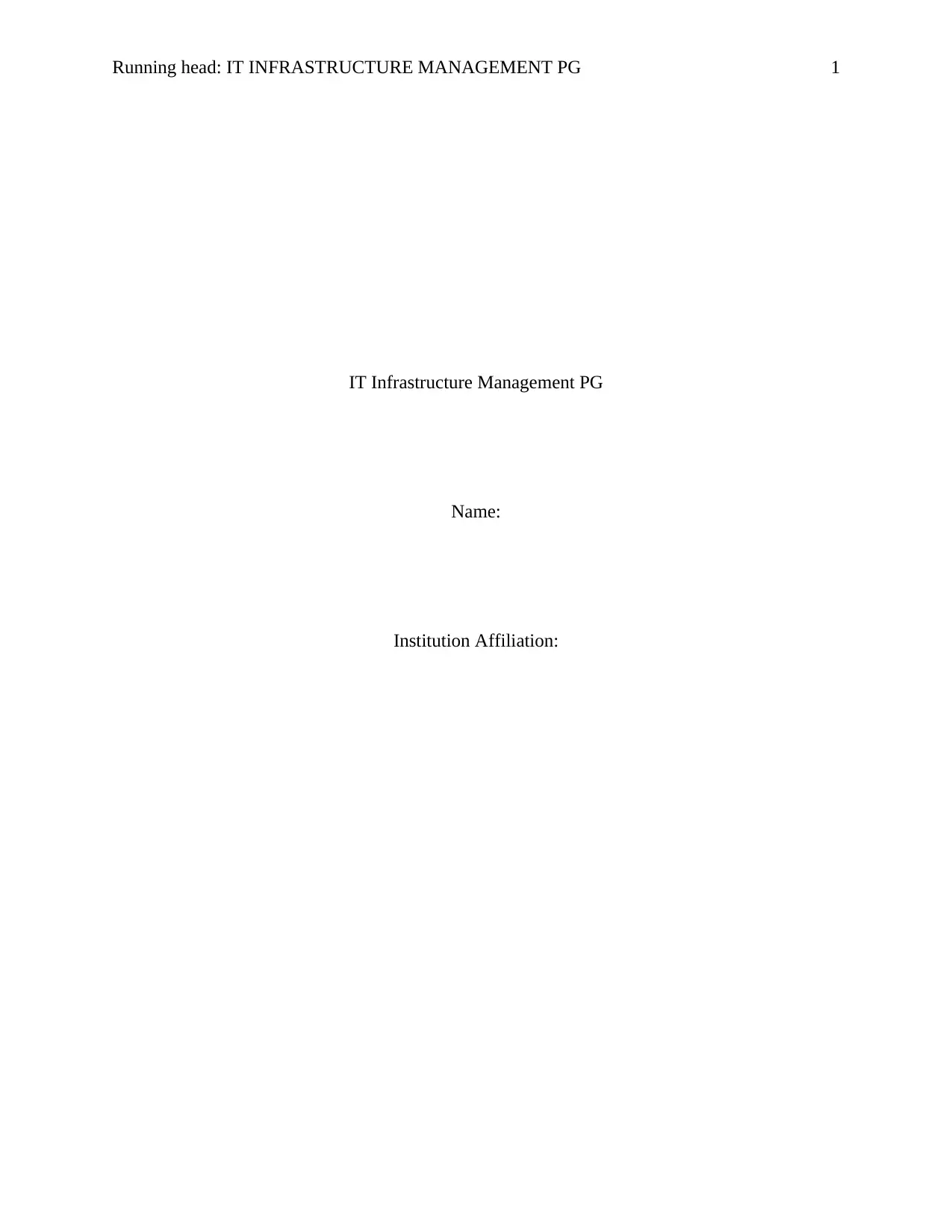
Running head: IT INFRASTRUCTURE MANAGEMENT PG 1
IT Infrastructure Management PG
Name:
Institution Affiliation:
IT Infrastructure Management PG
Name:
Institution Affiliation:
Paraphrase This Document
Need a fresh take? Get an instant paraphrase of this document with our AI Paraphraser
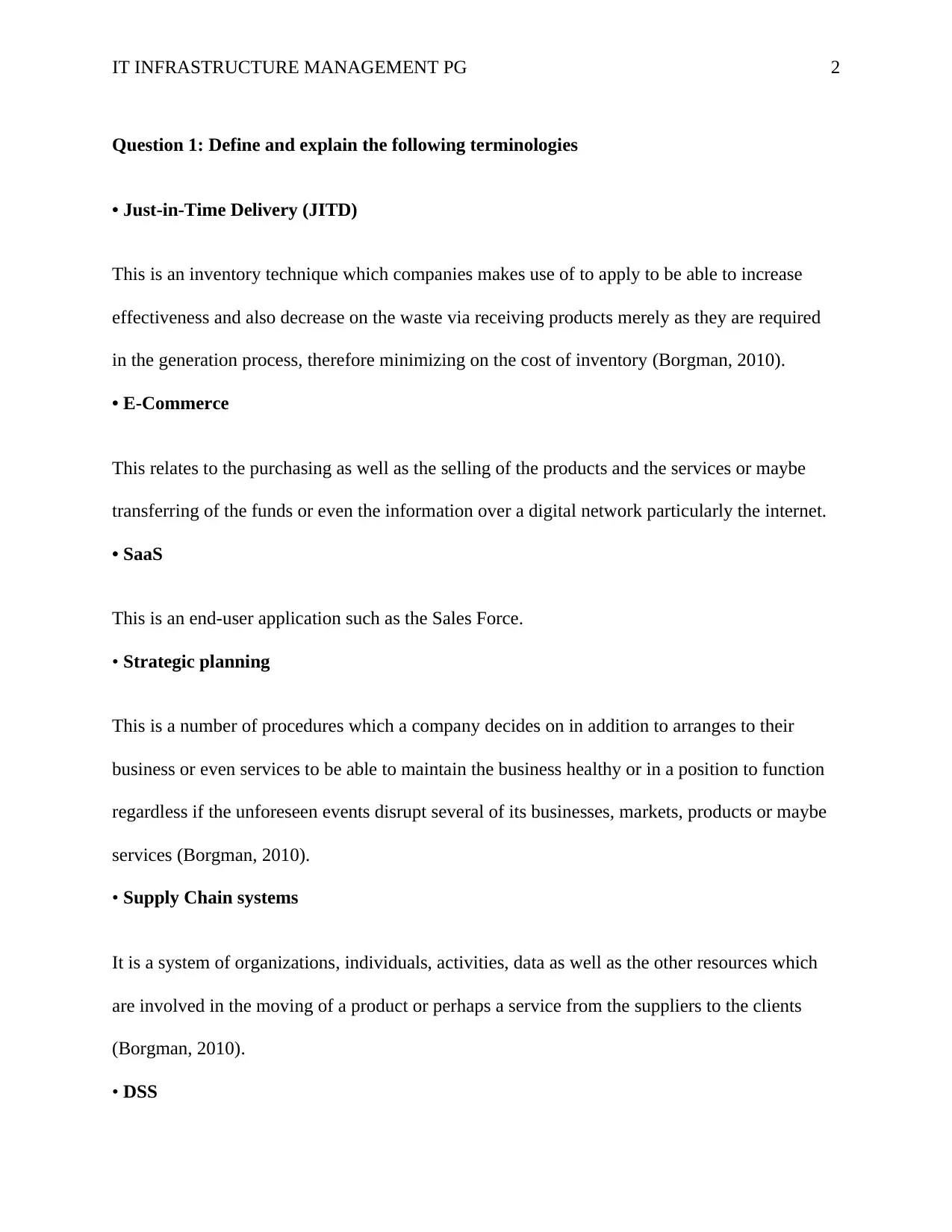
IT INFRASTRUCTURE MANAGEMENT PG 2
Question 1: Define and explain the following terminologies
• Just-in-Time Delivery (JITD)
This is an inventory technique which companies makes use of to apply to be able to increase
effectiveness and also decrease on the waste via receiving products merely as they are required
in the generation process, therefore minimizing on the cost of inventory (Borgman, 2010).
• E-Commerce
This relates to the purchasing as well as the selling of the products and the services or maybe
transferring of the funds or even the information over a digital network particularly the internet.
• SaaS
This is an end-user application such as the Sales Force.
• Strategic planning
This is a number of procedures which a company decides on in addition to arranges to their
business or even services to be able to maintain the business healthy or in a position to function
regardless if the unforeseen events disrupt several of its businesses, markets, products or maybe
services (Borgman, 2010).
• Supply Chain systems
It is a system of organizations, individuals, activities, data as well as the other resources which
are involved in the moving of a product or perhaps a service from the suppliers to the clients
(Borgman, 2010).
• DSS
Question 1: Define and explain the following terminologies
• Just-in-Time Delivery (JITD)
This is an inventory technique which companies makes use of to apply to be able to increase
effectiveness and also decrease on the waste via receiving products merely as they are required
in the generation process, therefore minimizing on the cost of inventory (Borgman, 2010).
• E-Commerce
This relates to the purchasing as well as the selling of the products and the services or maybe
transferring of the funds or even the information over a digital network particularly the internet.
• SaaS
This is an end-user application such as the Sales Force.
• Strategic planning
This is a number of procedures which a company decides on in addition to arranges to their
business or even services to be able to maintain the business healthy or in a position to function
regardless if the unforeseen events disrupt several of its businesses, markets, products or maybe
services (Borgman, 2010).
• Supply Chain systems
It is a system of organizations, individuals, activities, data as well as the other resources which
are involved in the moving of a product or perhaps a service from the suppliers to the clients
(Borgman, 2010).
• DSS
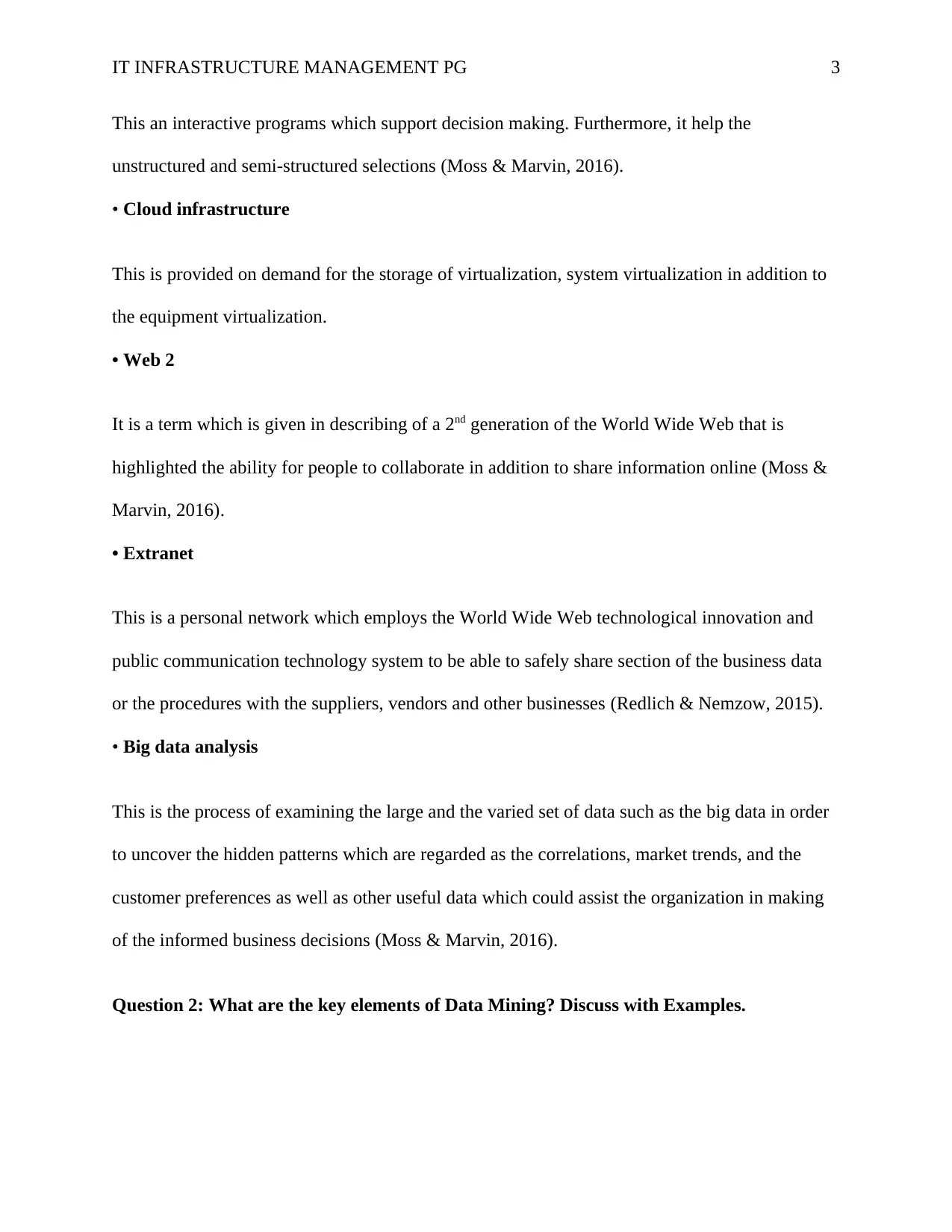
IT INFRASTRUCTURE MANAGEMENT PG 3
This an interactive programs which support decision making. Furthermore, it help the
unstructured and semi-structured selections (Moss & Marvin, 2016).
• Cloud infrastructure
This is provided on demand for the storage of virtualization, system virtualization in addition to
the equipment virtualization.
• Web 2
It is a term which is given in describing of a 2nd generation of the World Wide Web that is
highlighted the ability for people to collaborate in addition to share information online (Moss &
Marvin, 2016).
• Extranet
This is a personal network which employs the World Wide Web technological innovation and
public communication technology system to be able to safely share section of the business data
or the procedures with the suppliers, vendors and other businesses (Redlich & Nemzow, 2015).
• Big data analysis
This is the process of examining the large and the varied set of data such as the big data in order
to uncover the hidden patterns which are regarded as the correlations, market trends, and the
customer preferences as well as other useful data which could assist the organization in making
of the informed business decisions (Moss & Marvin, 2016).
Question 2: What are the key elements of Data Mining? Discuss with Examples.
This an interactive programs which support decision making. Furthermore, it help the
unstructured and semi-structured selections (Moss & Marvin, 2016).
• Cloud infrastructure
This is provided on demand for the storage of virtualization, system virtualization in addition to
the equipment virtualization.
• Web 2
It is a term which is given in describing of a 2nd generation of the World Wide Web that is
highlighted the ability for people to collaborate in addition to share information online (Moss &
Marvin, 2016).
• Extranet
This is a personal network which employs the World Wide Web technological innovation and
public communication technology system to be able to safely share section of the business data
or the procedures with the suppliers, vendors and other businesses (Redlich & Nemzow, 2015).
• Big data analysis
This is the process of examining the large and the varied set of data such as the big data in order
to uncover the hidden patterns which are regarded as the correlations, market trends, and the
customer preferences as well as other useful data which could assist the organization in making
of the informed business decisions (Moss & Marvin, 2016).
Question 2: What are the key elements of Data Mining? Discuss with Examples.
⊘ This is a preview!⊘
Do you want full access?
Subscribe today to unlock all pages.

Trusted by 1+ million students worldwide
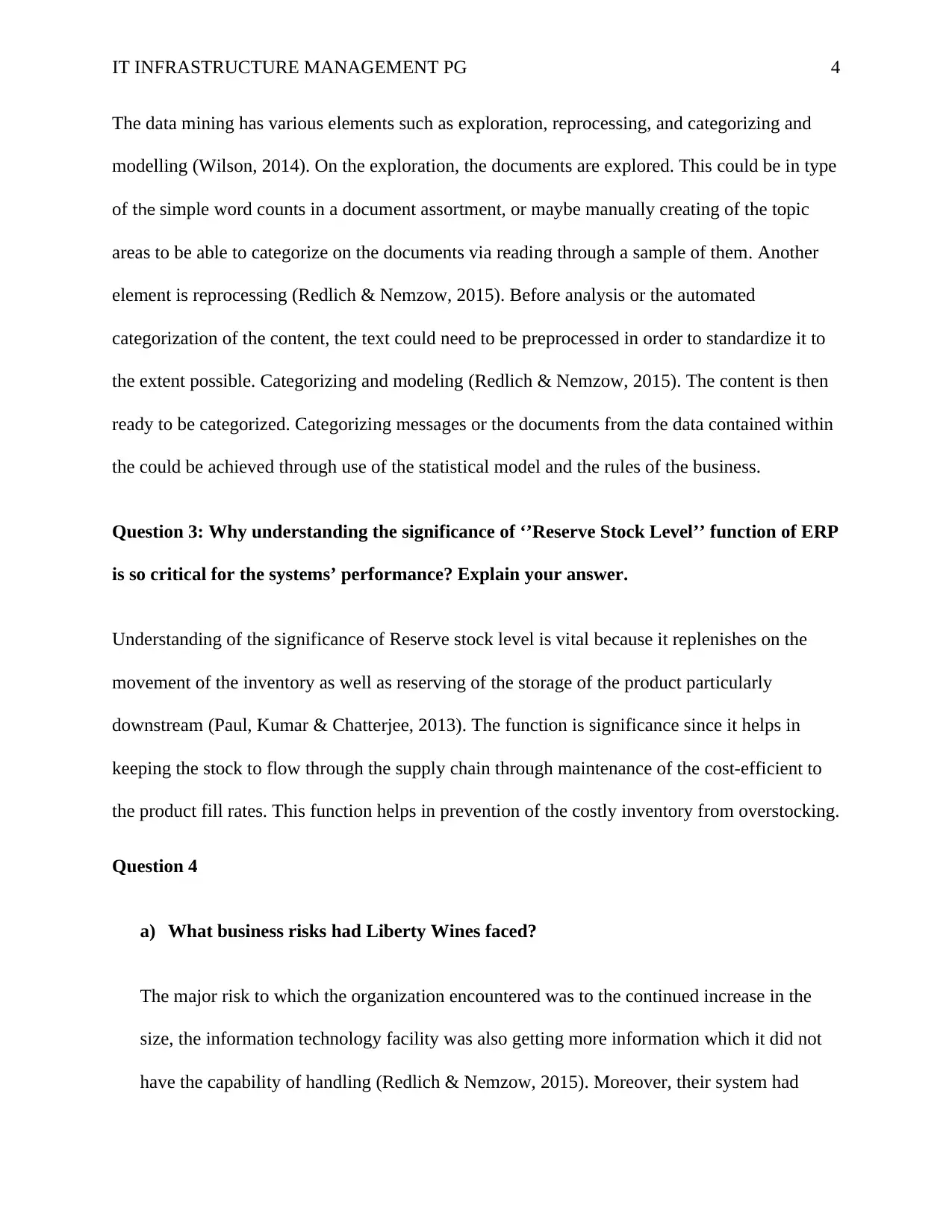
IT INFRASTRUCTURE MANAGEMENT PG 4
The data mining has various elements such as exploration, reprocessing, and categorizing and
modelling (Wilson, 2014). On the exploration, the documents are explored. This could be in type
of the simple word counts in a document assortment, or maybe manually creating of the topic
areas to be able to categorize on the documents via reading through a sample of them. Another
element is reprocessing (Redlich & Nemzow, 2015). Before analysis or the automated
categorization of the content, the text could need to be preprocessed in order to standardize it to
the extent possible. Categorizing and modeling (Redlich & Nemzow, 2015). The content is then
ready to be categorized. Categorizing messages or the documents from the data contained within
the could be achieved through use of the statistical model and the rules of the business.
Question 3: Why understanding the significance of ‘’Reserve Stock Level’’ function of ERP
is so critical for the systems’ performance? Explain your answer.
Understanding of the significance of Reserve stock level is vital because it replenishes on the
movement of the inventory as well as reserving of the storage of the product particularly
downstream (Paul, Kumar & Chatterjee, 2013). The function is significance since it helps in
keeping the stock to flow through the supply chain through maintenance of the cost-efficient to
the product fill rates. This function helps in prevention of the costly inventory from overstocking.
Question 4
a) What business risks had Liberty Wines faced?
The major risk to which the organization encountered was to the continued increase in the
size, the information technology facility was also getting more information which it did not
have the capability of handling (Redlich & Nemzow, 2015). Moreover, their system had
The data mining has various elements such as exploration, reprocessing, and categorizing and
modelling (Wilson, 2014). On the exploration, the documents are explored. This could be in type
of the simple word counts in a document assortment, or maybe manually creating of the topic
areas to be able to categorize on the documents via reading through a sample of them. Another
element is reprocessing (Redlich & Nemzow, 2015). Before analysis or the automated
categorization of the content, the text could need to be preprocessed in order to standardize it to
the extent possible. Categorizing and modeling (Redlich & Nemzow, 2015). The content is then
ready to be categorized. Categorizing messages or the documents from the data contained within
the could be achieved through use of the statistical model and the rules of the business.
Question 3: Why understanding the significance of ‘’Reserve Stock Level’’ function of ERP
is so critical for the systems’ performance? Explain your answer.
Understanding of the significance of Reserve stock level is vital because it replenishes on the
movement of the inventory as well as reserving of the storage of the product particularly
downstream (Paul, Kumar & Chatterjee, 2013). The function is significance since it helps in
keeping the stock to flow through the supply chain through maintenance of the cost-efficient to
the product fill rates. This function helps in prevention of the costly inventory from overstocking.
Question 4
a) What business risks had Liberty Wines faced?
The major risk to which the organization encountered was to the continued increase in the
size, the information technology facility was also getting more information which it did not
have the capability of handling (Redlich & Nemzow, 2015). Moreover, their system had
Paraphrase This Document
Need a fresh take? Get an instant paraphrase of this document with our AI Paraphraser
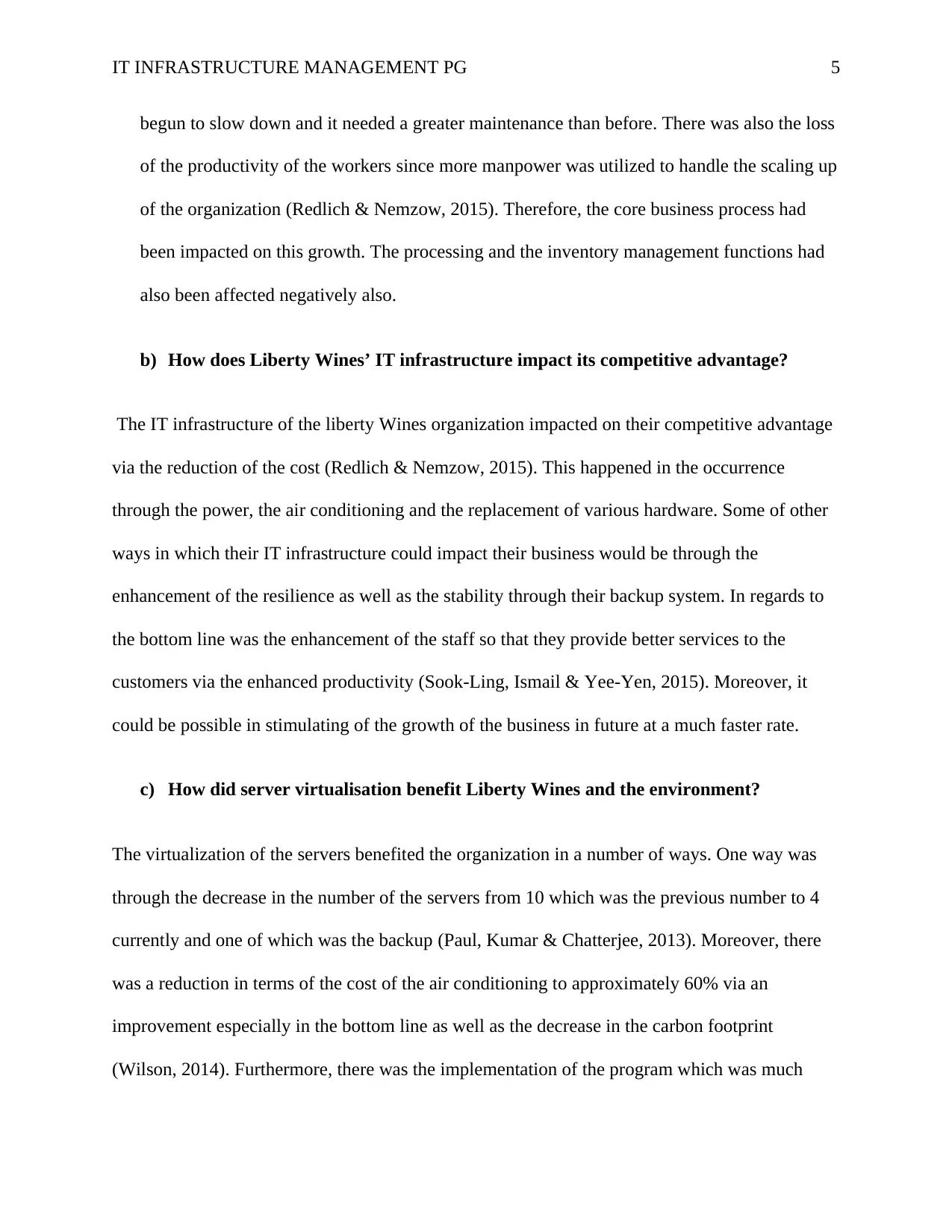
IT INFRASTRUCTURE MANAGEMENT PG 5
begun to slow down and it needed a greater maintenance than before. There was also the loss
of the productivity of the workers since more manpower was utilized to handle the scaling up
of the organization (Redlich & Nemzow, 2015). Therefore, the core business process had
been impacted on this growth. The processing and the inventory management functions had
also been affected negatively also.
b) How does Liberty Wines’ IT infrastructure impact its competitive advantage?
The IT infrastructure of the liberty Wines organization impacted on their competitive advantage
via the reduction of the cost (Redlich & Nemzow, 2015). This happened in the occurrence
through the power, the air conditioning and the replacement of various hardware. Some of other
ways in which their IT infrastructure could impact their business would be through the
enhancement of the resilience as well as the stability through their backup system. In regards to
the bottom line was the enhancement of the staff so that they provide better services to the
customers via the enhanced productivity (Sook-Ling, Ismail & Yee-Yen, 2015). Moreover, it
could be possible in stimulating of the growth of the business in future at a much faster rate.
c) How did server virtualisation benefit Liberty Wines and the environment?
The virtualization of the servers benefited the organization in a number of ways. One way was
through the decrease in the number of the servers from 10 which was the previous number to 4
currently and one of which was the backup (Paul, Kumar & Chatterjee, 2013). Moreover, there
was a reduction in terms of the cost of the air conditioning to approximately 60% via an
improvement especially in the bottom line as well as the decrease in the carbon footprint
(Wilson, 2014). Furthermore, there was the implementation of the program which was much
begun to slow down and it needed a greater maintenance than before. There was also the loss
of the productivity of the workers since more manpower was utilized to handle the scaling up
of the organization (Redlich & Nemzow, 2015). Therefore, the core business process had
been impacted on this growth. The processing and the inventory management functions had
also been affected negatively also.
b) How does Liberty Wines’ IT infrastructure impact its competitive advantage?
The IT infrastructure of the liberty Wines organization impacted on their competitive advantage
via the reduction of the cost (Redlich & Nemzow, 2015). This happened in the occurrence
through the power, the air conditioning and the replacement of various hardware. Some of other
ways in which their IT infrastructure could impact their business would be through the
enhancement of the resilience as well as the stability through their backup system. In regards to
the bottom line was the enhancement of the staff so that they provide better services to the
customers via the enhanced productivity (Sook-Ling, Ismail & Yee-Yen, 2015). Moreover, it
could be possible in stimulating of the growth of the business in future at a much faster rate.
c) How did server virtualisation benefit Liberty Wines and the environment?
The virtualization of the servers benefited the organization in a number of ways. One way was
through the decrease in the number of the servers from 10 which was the previous number to 4
currently and one of which was the backup (Paul, Kumar & Chatterjee, 2013). Moreover, there
was a reduction in terms of the cost of the air conditioning to approximately 60% via an
improvement especially in the bottom line as well as the decrease in the carbon footprint
(Wilson, 2014). Furthermore, there was the implementation of the program which was much
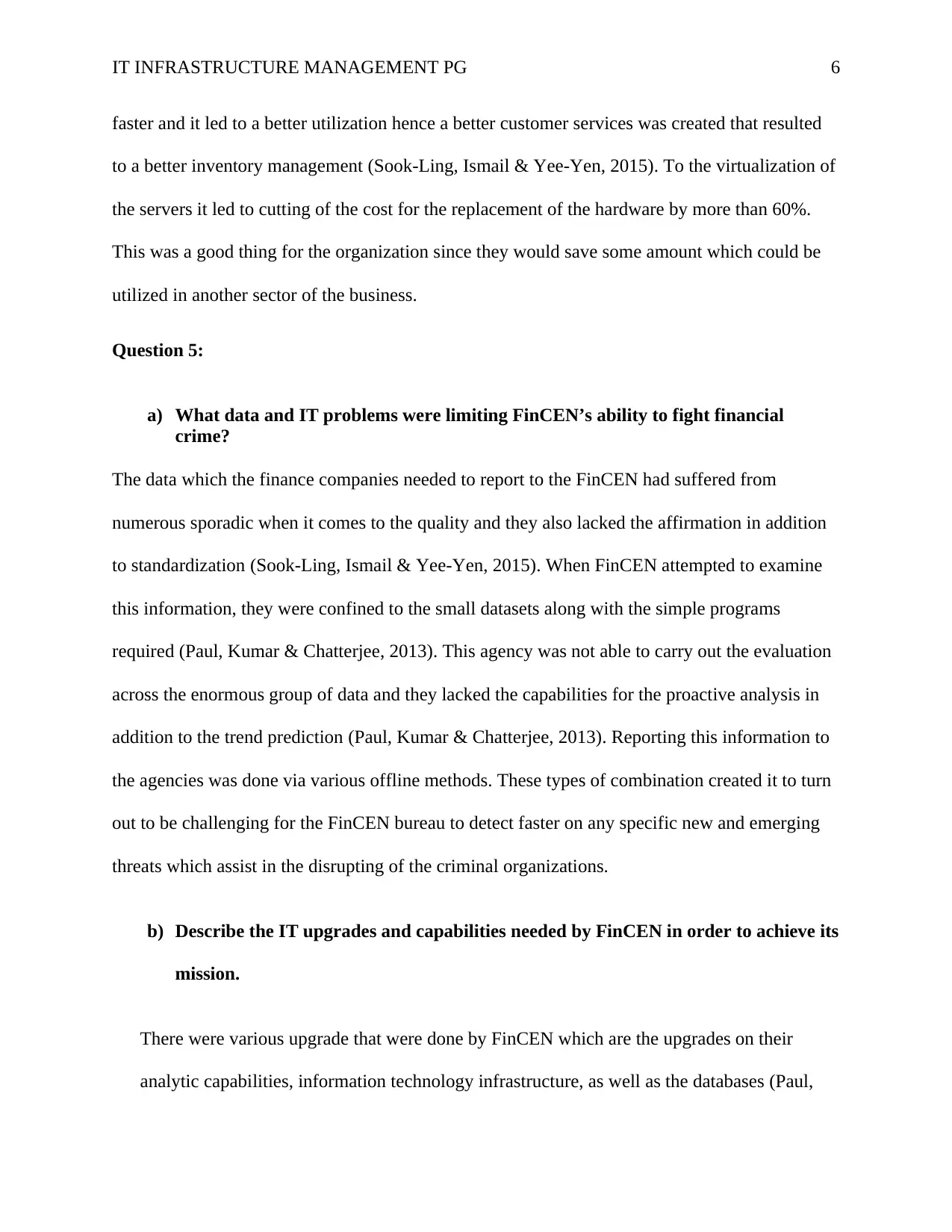
IT INFRASTRUCTURE MANAGEMENT PG 6
faster and it led to a better utilization hence a better customer services was created that resulted
to a better inventory management (Sook-Ling, Ismail & Yee-Yen, 2015). To the virtualization of
the servers it led to cutting of the cost for the replacement of the hardware by more than 60%.
This was a good thing for the organization since they would save some amount which could be
utilized in another sector of the business.
Question 5:
a) What data and IT problems were limiting FinCEN’s ability to fight financial
crime?
The data which the finance companies needed to report to the FinCEN had suffered from
numerous sporadic when it comes to the quality and they also lacked the affirmation in addition
to standardization (Sook-Ling, Ismail & Yee-Yen, 2015). When FinCEN attempted to examine
this information, they were confined to the small datasets along with the simple programs
required (Paul, Kumar & Chatterjee, 2013). This agency was not able to carry out the evaluation
across the enormous group of data and they lacked the capabilities for the proactive analysis in
addition to the trend prediction (Paul, Kumar & Chatterjee, 2013). Reporting this information to
the agencies was done via various offline methods. These types of combination created it to turn
out to be challenging for the FinCEN bureau to detect faster on any specific new and emerging
threats which assist in the disrupting of the criminal organizations.
b) Describe the IT upgrades and capabilities needed by FinCEN in order to achieve its
mission.
There were various upgrade that were done by FinCEN which are the upgrades on their
analytic capabilities, information technology infrastructure, as well as the databases (Paul,
faster and it led to a better utilization hence a better customer services was created that resulted
to a better inventory management (Sook-Ling, Ismail & Yee-Yen, 2015). To the virtualization of
the servers it led to cutting of the cost for the replacement of the hardware by more than 60%.
This was a good thing for the organization since they would save some amount which could be
utilized in another sector of the business.
Question 5:
a) What data and IT problems were limiting FinCEN’s ability to fight financial
crime?
The data which the finance companies needed to report to the FinCEN had suffered from
numerous sporadic when it comes to the quality and they also lacked the affirmation in addition
to standardization (Sook-Ling, Ismail & Yee-Yen, 2015). When FinCEN attempted to examine
this information, they were confined to the small datasets along with the simple programs
required (Paul, Kumar & Chatterjee, 2013). This agency was not able to carry out the evaluation
across the enormous group of data and they lacked the capabilities for the proactive analysis in
addition to the trend prediction (Paul, Kumar & Chatterjee, 2013). Reporting this information to
the agencies was done via various offline methods. These types of combination created it to turn
out to be challenging for the FinCEN bureau to detect faster on any specific new and emerging
threats which assist in the disrupting of the criminal organizations.
b) Describe the IT upgrades and capabilities needed by FinCEN in order to achieve its
mission.
There were various upgrade that were done by FinCEN which are the upgrades on their
analytic capabilities, information technology infrastructure, as well as the databases (Paul,
⊘ This is a preview!⊘
Do you want full access?
Subscribe today to unlock all pages.

Trusted by 1+ million students worldwide
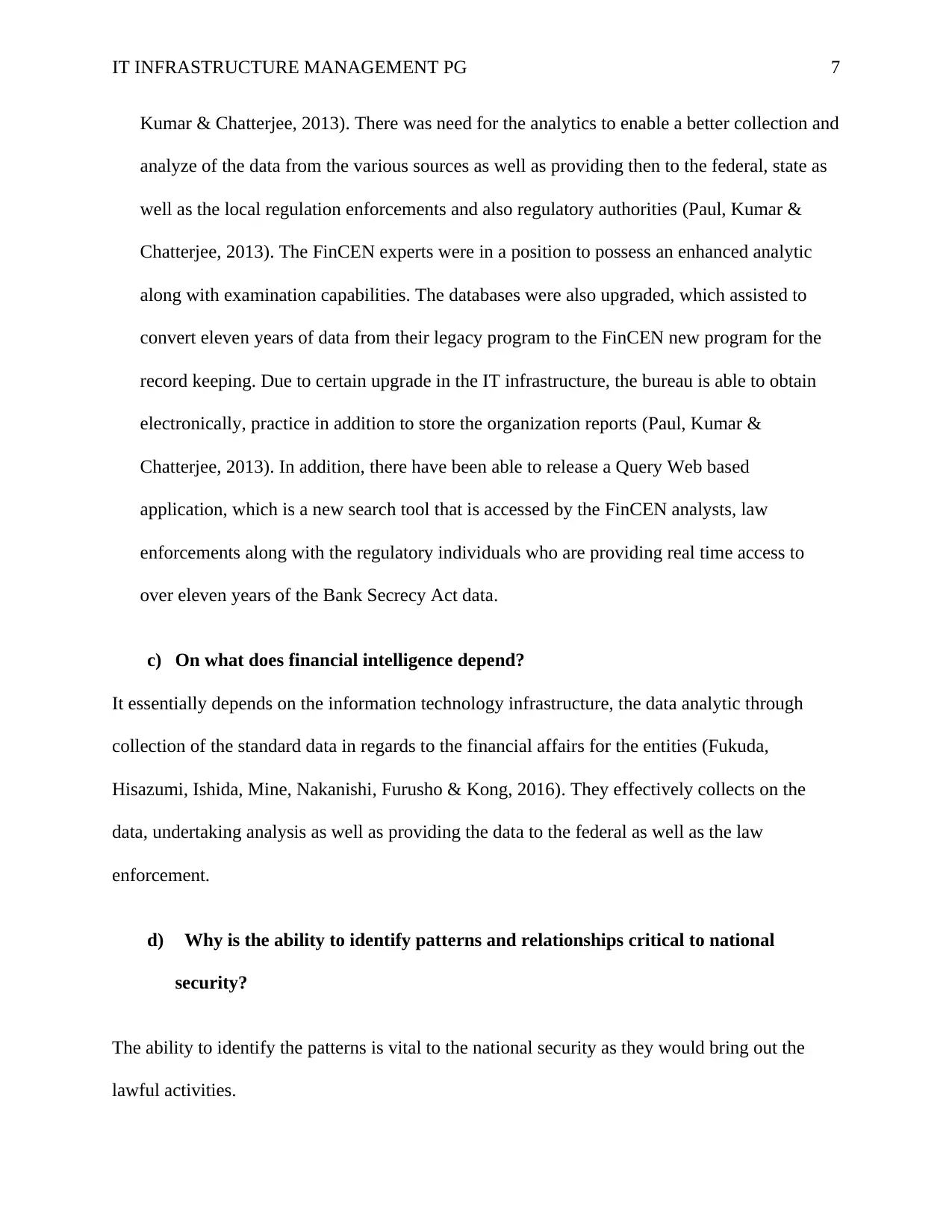
IT INFRASTRUCTURE MANAGEMENT PG 7
Kumar & Chatterjee, 2013). There was need for the analytics to enable a better collection and
analyze of the data from the various sources as well as providing then to the federal, state as
well as the local regulation enforcements and also regulatory authorities (Paul, Kumar &
Chatterjee, 2013). The FinCEN experts were in a position to possess an enhanced analytic
along with examination capabilities. The databases were also upgraded, which assisted to
convert eleven years of data from their legacy program to the FinCEN new program for the
record keeping. Due to certain upgrade in the IT infrastructure, the bureau is able to obtain
electronically, practice in addition to store the organization reports (Paul, Kumar &
Chatterjee, 2013). In addition, there have been able to release a Query Web based
application, which is a new search tool that is accessed by the FinCEN analysts, law
enforcements along with the regulatory individuals who are providing real time access to
over eleven years of the Bank Secrecy Act data.
c) On what does financial intelligence depend?
It essentially depends on the information technology infrastructure, the data analytic through
collection of the standard data in regards to the financial affairs for the entities (Fukuda,
Hisazumi, Ishida, Mine, Nakanishi, Furusho & Kong, 2016). They effectively collects on the
data, undertaking analysis as well as providing the data to the federal as well as the law
enforcement.
d) Why is the ability to identify patterns and relationships critical to national
security?
The ability to identify the patterns is vital to the national security as they would bring out the
lawful activities.
Kumar & Chatterjee, 2013). There was need for the analytics to enable a better collection and
analyze of the data from the various sources as well as providing then to the federal, state as
well as the local regulation enforcements and also regulatory authorities (Paul, Kumar &
Chatterjee, 2013). The FinCEN experts were in a position to possess an enhanced analytic
along with examination capabilities. The databases were also upgraded, which assisted to
convert eleven years of data from their legacy program to the FinCEN new program for the
record keeping. Due to certain upgrade in the IT infrastructure, the bureau is able to obtain
electronically, practice in addition to store the organization reports (Paul, Kumar &
Chatterjee, 2013). In addition, there have been able to release a Query Web based
application, which is a new search tool that is accessed by the FinCEN analysts, law
enforcements along with the regulatory individuals who are providing real time access to
over eleven years of the Bank Secrecy Act data.
c) On what does financial intelligence depend?
It essentially depends on the information technology infrastructure, the data analytic through
collection of the standard data in regards to the financial affairs for the entities (Fukuda,
Hisazumi, Ishida, Mine, Nakanishi, Furusho & Kong, 2016). They effectively collects on the
data, undertaking analysis as well as providing the data to the federal as well as the law
enforcement.
d) Why is the ability to identify patterns and relationships critical to national
security?
The ability to identify the patterns is vital to the national security as they would bring out the
lawful activities.
Paraphrase This Document
Need a fresh take? Get an instant paraphrase of this document with our AI Paraphraser
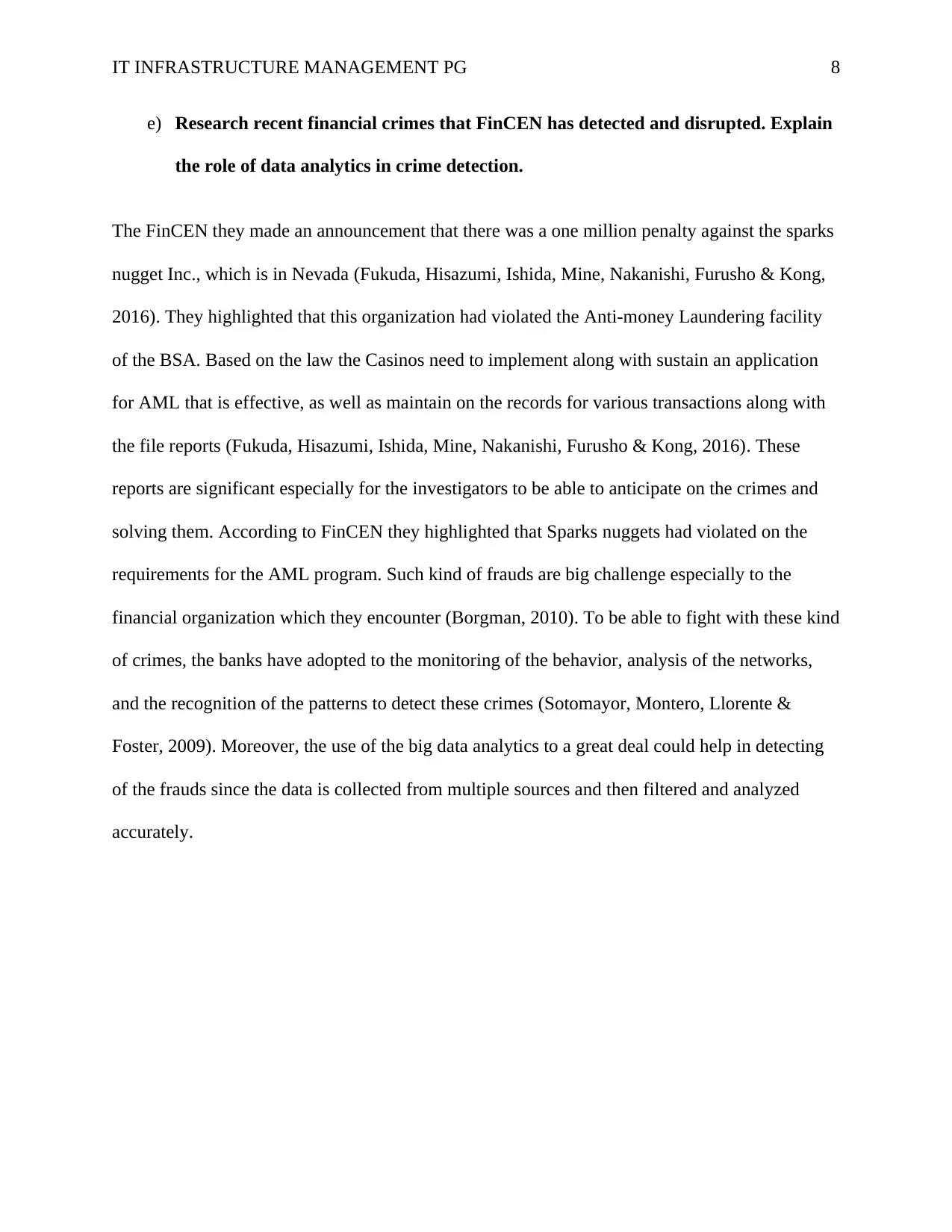
IT INFRASTRUCTURE MANAGEMENT PG 8
e) Research recent financial crimes that FinCEN has detected and disrupted. Explain
the role of data analytics in crime detection.
The FinCEN they made an announcement that there was a one million penalty against the sparks
nugget Inc., which is in Nevada (Fukuda, Hisazumi, Ishida, Mine, Nakanishi, Furusho & Kong,
2016). They highlighted that this organization had violated the Anti-money Laundering facility
of the BSA. Based on the law the Casinos need to implement along with sustain an application
for AML that is effective, as well as maintain on the records for various transactions along with
the file reports (Fukuda, Hisazumi, Ishida, Mine, Nakanishi, Furusho & Kong, 2016). These
reports are significant especially for the investigators to be able to anticipate on the crimes and
solving them. According to FinCEN they highlighted that Sparks nuggets had violated on the
requirements for the AML program. Such kind of frauds are big challenge especially to the
financial organization which they encounter (Borgman, 2010). To be able to fight with these kind
of crimes, the banks have adopted to the monitoring of the behavior, analysis of the networks,
and the recognition of the patterns to detect these crimes (Sotomayor, Montero, Llorente &
Foster, 2009). Moreover, the use of the big data analytics to a great deal could help in detecting
of the frauds since the data is collected from multiple sources and then filtered and analyzed
accurately.
e) Research recent financial crimes that FinCEN has detected and disrupted. Explain
the role of data analytics in crime detection.
The FinCEN they made an announcement that there was a one million penalty against the sparks
nugget Inc., which is in Nevada (Fukuda, Hisazumi, Ishida, Mine, Nakanishi, Furusho & Kong,
2016). They highlighted that this organization had violated the Anti-money Laundering facility
of the BSA. Based on the law the Casinos need to implement along with sustain an application
for AML that is effective, as well as maintain on the records for various transactions along with
the file reports (Fukuda, Hisazumi, Ishida, Mine, Nakanishi, Furusho & Kong, 2016). These
reports are significant especially for the investigators to be able to anticipate on the crimes and
solving them. According to FinCEN they highlighted that Sparks nuggets had violated on the
requirements for the AML program. Such kind of frauds are big challenge especially to the
financial organization which they encounter (Borgman, 2010). To be able to fight with these kind
of crimes, the banks have adopted to the monitoring of the behavior, analysis of the networks,
and the recognition of the patterns to detect these crimes (Sotomayor, Montero, Llorente &
Foster, 2009). Moreover, the use of the big data analytics to a great deal could help in detecting
of the frauds since the data is collected from multiple sources and then filtered and analyzed
accurately.
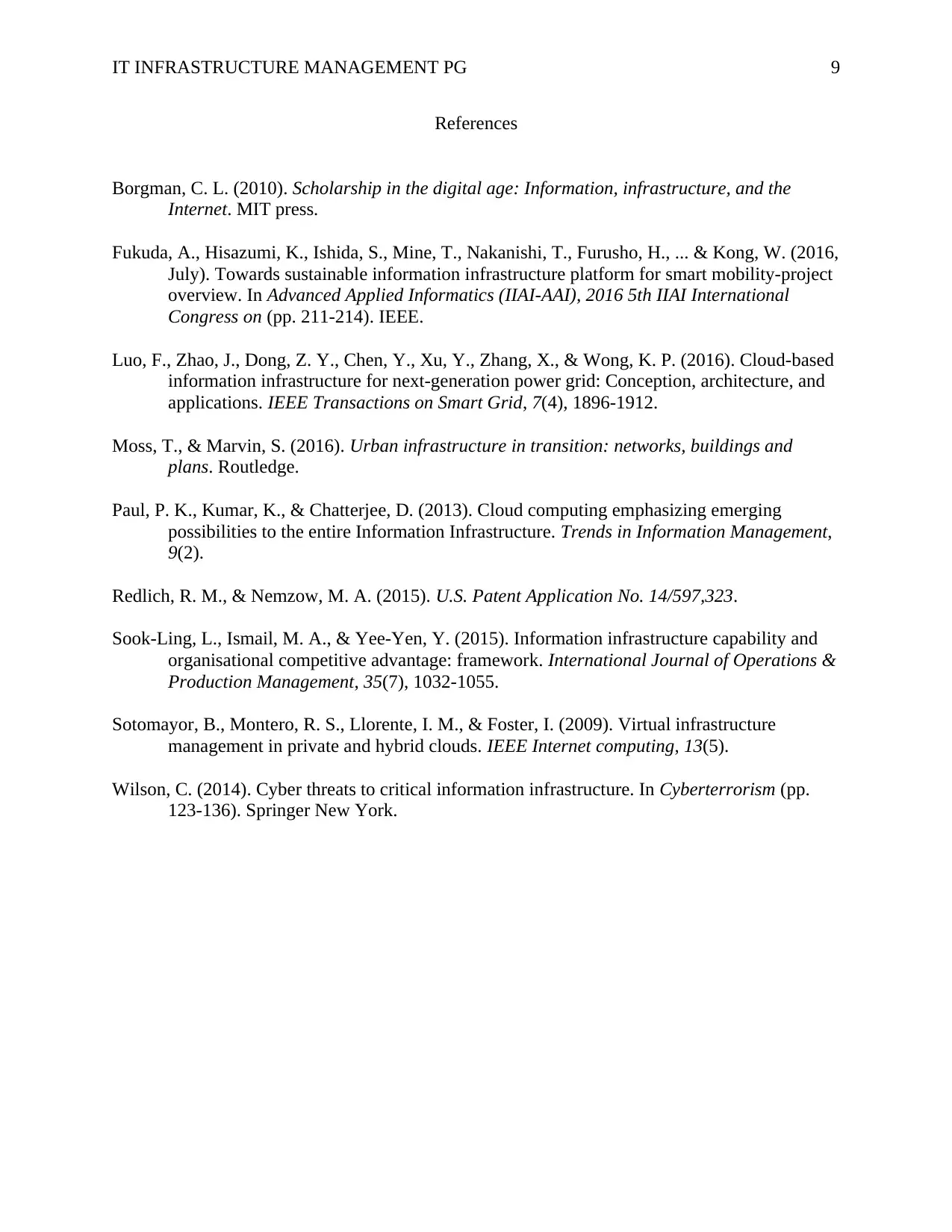
IT INFRASTRUCTURE MANAGEMENT PG 9
References
Borgman, C. L. (2010). Scholarship in the digital age: Information, infrastructure, and the
Internet. MIT press.
Fukuda, A., Hisazumi, K., Ishida, S., Mine, T., Nakanishi, T., Furusho, H., ... & Kong, W. (2016,
July). Towards sustainable information infrastructure platform for smart mobility-project
overview. In Advanced Applied Informatics (IIAI-AAI), 2016 5th IIAI International
Congress on (pp. 211-214). IEEE.
Luo, F., Zhao, J., Dong, Z. Y., Chen, Y., Xu, Y., Zhang, X., & Wong, K. P. (2016). Cloud-based
information infrastructure for next-generation power grid: Conception, architecture, and
applications. IEEE Transactions on Smart Grid, 7(4), 1896-1912.
Moss, T., & Marvin, S. (2016). Urban infrastructure in transition: networks, buildings and
plans. Routledge.
Paul, P. K., Kumar, K., & Chatterjee, D. (2013). Cloud computing emphasizing emerging
possibilities to the entire Information Infrastructure. Trends in Information Management,
9(2).
Redlich, R. M., & Nemzow, M. A. (2015). U.S. Patent Application No. 14/597,323.
Sook-Ling, L., Ismail, M. A., & Yee-Yen, Y. (2015). Information infrastructure capability and
organisational competitive advantage: framework. International Journal of Operations &
Production Management, 35(7), 1032-1055.
Sotomayor, B., Montero, R. S., Llorente, I. M., & Foster, I. (2009). Virtual infrastructure
management in private and hybrid clouds. IEEE Internet computing, 13(5).
Wilson, C. (2014). Cyber threats to critical information infrastructure. In Cyberterrorism (pp.
123-136). Springer New York.
References
Borgman, C. L. (2010). Scholarship in the digital age: Information, infrastructure, and the
Internet. MIT press.
Fukuda, A., Hisazumi, K., Ishida, S., Mine, T., Nakanishi, T., Furusho, H., ... & Kong, W. (2016,
July). Towards sustainable information infrastructure platform for smart mobility-project
overview. In Advanced Applied Informatics (IIAI-AAI), 2016 5th IIAI International
Congress on (pp. 211-214). IEEE.
Luo, F., Zhao, J., Dong, Z. Y., Chen, Y., Xu, Y., Zhang, X., & Wong, K. P. (2016). Cloud-based
information infrastructure for next-generation power grid: Conception, architecture, and
applications. IEEE Transactions on Smart Grid, 7(4), 1896-1912.
Moss, T., & Marvin, S. (2016). Urban infrastructure in transition: networks, buildings and
plans. Routledge.
Paul, P. K., Kumar, K., & Chatterjee, D. (2013). Cloud computing emphasizing emerging
possibilities to the entire Information Infrastructure. Trends in Information Management,
9(2).
Redlich, R. M., & Nemzow, M. A. (2015). U.S. Patent Application No. 14/597,323.
Sook-Ling, L., Ismail, M. A., & Yee-Yen, Y. (2015). Information infrastructure capability and
organisational competitive advantage: framework. International Journal of Operations &
Production Management, 35(7), 1032-1055.
Sotomayor, B., Montero, R. S., Llorente, I. M., & Foster, I. (2009). Virtual infrastructure
management in private and hybrid clouds. IEEE Internet computing, 13(5).
Wilson, C. (2014). Cyber threats to critical information infrastructure. In Cyberterrorism (pp.
123-136). Springer New York.
⊘ This is a preview!⊘
Do you want full access?
Subscribe today to unlock all pages.

Trusted by 1+ million students worldwide
1 out of 9
Your All-in-One AI-Powered Toolkit for Academic Success.
+13062052269
info@desklib.com
Available 24*7 on WhatsApp / Email
![[object Object]](/_next/static/media/star-bottom.7253800d.svg)
Unlock your academic potential
Copyright © 2020–2025 A2Z Services. All Rights Reserved. Developed and managed by ZUCOL.

